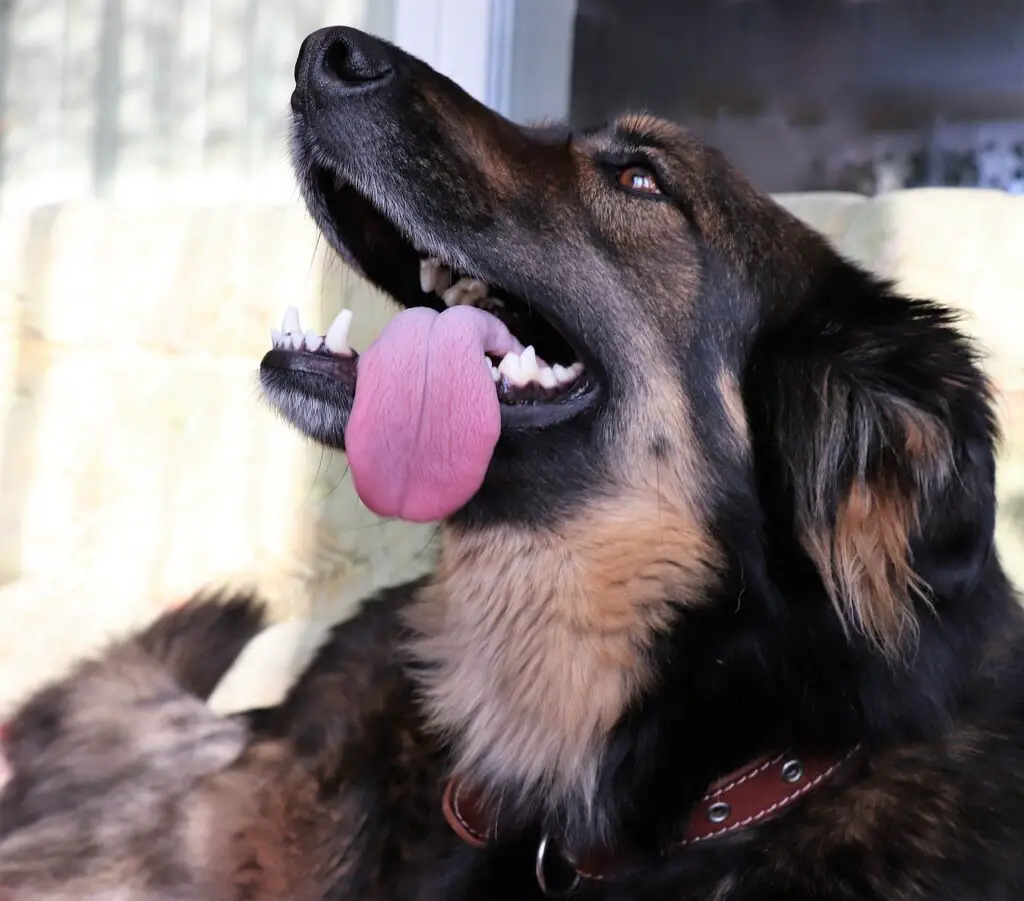Rabies is a deadly disease that can be transmitted to humans and other animals through the saliva of an infected animal, most commonly via bites.
While the most common mode of transmission is through bites, the virus can also enter the body through open wounds or mucous membranes exposed to saliva.
It’s crucial to seek immediate medical attention if you suspect exposure to rabies, as post-exposure treatment can prevent the development of the disease.
Key Takeaway
- Dog saliva can cause rabies as the virus is transmitted through contact with the saliva of an infected animal, not just through bites.
- It is possible for rabies to spread if a dog licks you, but the risk is low unless the dog’s saliva enters an open wound or mucous membranes.
- While it is possible for dog saliva in food to contain the rabies virus, the risk of contracting rabies from ingesting such food is extremely low.
Can Dog Saliva Cause Rabies?

Yes, dog saliva can cause rabies, but only if the dog is infected with the disease. Rabies is a viral disease that affects the nervous system of mammals.
It’s primarily transmitted through the saliva of an infected animal, often through a bite.
According to the World Health Organization and various other health bodies, once the rabies virus enters the body, it travels to the brain and spinal cord, causing a range of severe neurological symptoms.
However, it’s important to note that not all dogs carry the rabies virus. The virus is present in an animal only if it’s infected with rabies.
Dogs that are regularly vaccinated against rabies are highly unlikely to contract or spread the disease.
Regular vaccination and avoiding contact with unknown or wild animals is crucial in preventing the spread of this deadly disease.
Can a Person Get Rabies From Dog Saliva?

Yes, a person can get rabies from the saliva of an infected dog. The rabies virus is primarily spread to people through a bite from an infected animal.
It is present in the saliva and is transmitted when the animal bites another creature.
However, it’s not just bites that can cause transmission. If the saliva from an infected animal comes into contact with a person’s eyes, mouth, or wound, there is also a risk of getting rabies.
This means that if an infected dog licks a person’s open cut, or if their saliva somehow gets into a person’s mouth or eyes, there’s a potential risk of transmission.
Can Rabies Spread If a Dog Licks You?
Yes, it is possible for a dog to spread rabies if it licks you in the face. Rabies is an infectious virus that can be transmitted through saliva or other body fluids of infected animals.
While rabies is most often associated with dogs, cats and other mammals such as raccoons, bats, foxes, and skunks can also carry the virus.
If a rabid animal’s saliva comes into contact with a person’s mucous membranes (such as eyes, nose, or mouth) or open wound, they are at risk for contracting rabies.
Being licked by an animal on the face would therefore put someone at risk of being exposed to the virus.
Can Dog Saliva In Food Cause Rabies?
If a dog with rabies were to lick food, there is a theoretical possibility for the food to become contaminated with the virus.
However, it’s important to note that the rabies virus typically doesn’t survive long outside its host, and consuming the virus does not usually lead to infection.
The process of eating food, which involves ingestion into the gastrointestinal tract, is not a typical route for rabies transmission.
One source suggests that even if food was contaminated with the saliva of a rabid animal, the virus would not survive in the gastrointestinal tract. Hence, there’s no need for vaccination in such cases.
Can Rabies Only Survive In Saliva?
The virus is short-lived when exposed to open air, meaning it cannot survive for long in saliva that has dried up. It is also sensitive to desiccation (drying out) and ultraviolet light, both of which can kill the virus.
In terms of surviving outside of a host, the rabies virus can live for a few hours in saliva and body fluids, but it can live for days inside the body, particularly in the brain.
How Likely Is It To Get Rabies From Saliva?
It is quite likely to get rabies if the saliva comes into contact with open wounds, scratches, abrasions, or mucous membranes such as the eyes, nose, or mouth.
Rabies is primarily transmitted through a bite from an infected animal which allows the virus in the saliva to enter directly into the bloodstream.
However, it’s also possible, but quite rare, for people to get rabies if infectious material such as saliva from a rabid animal gets directly into their eyes, nose, mouth, or a wound.
In most cases, this would involve being bitten or scratched by an infected animal rather than just coming into contact with the saliva.
How Long Can Rabies In Saliva Live On An Object
When spread thinly onto surfaces like glass, metal, or leaves, rabies has been observed to survive up to 144 hours under certain conditions.
Rabies is a virus that does not survive long outside of its host organism. When exposed to the environment, such as being on an object, the virus typically survives only for a few hours.
The exact duration can depend on various conditions like temperature and humidity.
According to some sources, the rabies virus can live for a few hours in saliva and body fluids outside the body.
How Long Does it Take For Rabies To Show In Humans?
It typically takes from 3 to 12 weeks for rabies to show in humans, but it can appear as early as a few days or take several months or even years in rare cases.
The incubation period depends on various factors like the location of the entry wound, the severity of the wound, and the amount of virus introduced.
Bites closer to the head and neck tend to have shorter incubation periods due to the proximity to the brain and spinal cord, where the virus multiplies and causes symptoms.
Initial symptoms of rabies are similar to the flu, including fever, headache, and general weakness or discomfort.
As the disease progresses, more specific symptoms appear, such as insomnia, anxiety, confusion, slight or partial paralysis, excitation, hallucinations, agitation, hypersalivation, difficulty swallowing, and fear of water.
FAQs
Q: Can dog saliva cause rabies?
A: Yes, dog saliva can potentially carry the rabies virus if the dog is infected. However, it is important to note that not all dogs have rabies, and the majority of dogs are vaccinated against the virus.
Q: What is rabies?
A: Rabies is a viral disease that affects the central nervous system in mammals, including humans. It is usually transmitted through the bite or scratch of an infected animal.
Q: How is rabies transmitted?
A: Rabies is most commonly transmitted through the bite or scratch of an infected animal, such as a dog, raccoon, bat, or skunk. The virus is present in the saliva of the infected animal and can enter the body through broken skin or mucous membranes.
Q: Can you get rabies from a dog licking you?
A: The chances of getting rabies from a dog licking you are extremely low. Rabies is primarily transmitted through the saliva of an infected animal entering the bloodstream through broken skin or mucous membranes, like a bite or scratch. Licking alone is not a significant risk factor for rabies transmission.
Q: What are the symptoms of rabies in dogs?
A: The symptoms of rabies in dogs can vary, but common signs include behavioral changes, increased aggression, excessive drooling, difficulty swallowing, paralysis, and seizures. It is important to seek veterinary attention if you suspect rabies in a dog.
Q: Can dogs be carriers of rabies without showing symptoms?
A: Yes, dogs can be carriers of the rabies virus without showing any symptoms. This is known as asymptomatic or silent carriers. These dogs can transmit the virus to other animals or humans through their saliva without exhibiting any signs of the disease themselves.
Q: How can you prevent rabies in dogs?
A: The most effective way to prevent rabies in dogs is through vaccination. Regular vaccination schedules recommended by veterinarians can help protect dogs from contracting the virus and reduce the risk of rabies transmission to humans or other animals.
Q: Can humans get rabies from dogs?
A: Yes, humans can get rabies from dogs if they are bitten or scratched by an infected dog. It is important to clean the wound thoroughly with soap and water and seek immediate medical attention to receive post-exposure prophylaxis, which includes vaccines and sometimes immunoglobulin injections.
Q: Can rabies be cured?
A: Unfortunately, rabies is almost always fatal once symptoms develop. However, immediate medical attention after exposure can prevent the onset of the disease through vaccination and the administration of immunoglobulin. Pre-exposure vaccination is recommended for individuals at high risk of exposure, such as veterinarians and animal handlers.
Q: How common is rabies in dogs?
A: The prevalence of rabies in dogs varies depending on the geographical location. In some countries where rabies is endemic, the virus remains a significant threat to both dogs and humans. Also, in other regions where rabies control measures, including vaccination programs, are implemented effectively, the incidence of rabies in dogs is significantly reduced.
In Conclusion
Dog saliva can indeed transmit rabies, but only if the dog is infected with the virus.
The most common route of transmission is through bites, but scratches and contact of saliva with open wounds or mucous membranes can also spread the disease.
Rabies is a deadly disease, but it’s preventable with timely vaccination and post-exposure treatment.
As such, ensuring that pets are vaccinated and avoiding contact with unknown or wild animals is crucial in the fight against rabies.





Leave a Reply